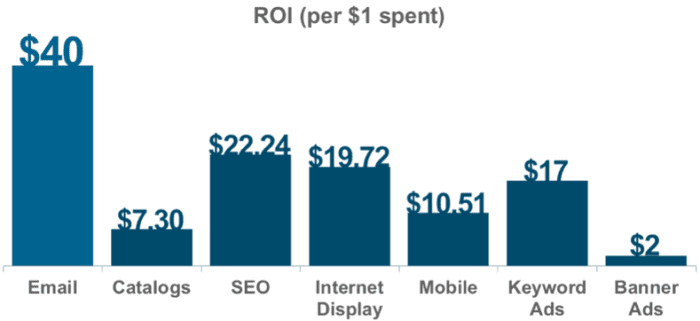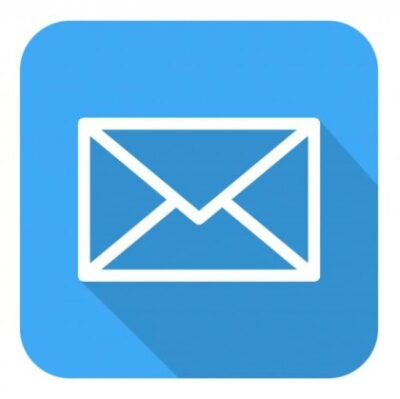With so many new channels and platforms emerging it can be a nightmare to constantly stay relevant and up to date on each new platform that comes out. But luckily for us marketers, there is one channel that we can still rely on and which is still relevant today – email.
So many people ask “Is email still relevant?” and the simple answer is YES! Email is still one of the most effective ways for businesses to communicate with their audience, retain existing customers, and acquire new customers.
In 2019 there were a staggering 3.9 billion people using emails regularly. It is estimated that there are 196 billion emails sent out daily, of which 109 billion are business emails.
As marketers, we should be harnessing the power of email as part of our overall marketing strategy. In case you are still in doubt, here are 6 reasons why email should still be an important and fundamental part of your marketing strategy.
1. Email is still growing at a staggering rate
When social media first emerged and started to gain popularity, many people thought that it would seal the fate of email. But even with all the instant messaging apps and various social media platforms at our disposal, the humble email not only continues to survive but thrive!
According to Statista:
“In 2018, approximately 281 billion e-mails were sent and received every day worldwide. This figure is projected to increase to over 347 billion daily e-mails in 2023”
Even with the huge growth and popularity of workplace messaging apps like Slack and Teams, email shows no signs of slowing. With more and more people using mobile as their number one device for going online, accessing their emails has never been easier.
Most people will have their email notifications on and will check their emails regularly. Some reports suggest that 80% of workers check their emails after work hours.
Ease of access means more people are engaged with email than ever before, so make sure you are taking advantage of this by sending out regular email communications.
2. Email is economical and cost effective
Email is one of the most cost effective marketing channels at your disposal. Compared to channels like television, radio, or print media – emails are relatively cheap, easy, and super efficient.
With the press of a button, you can send out communications, offers, and personalised messages to your audience at a fraction of the cost of the other channels mentioned above.
Email providers and auto-responders are very cost effective, and if you are just getting started building your list you can sign up for free trials or open free accounts which give you monthly send allowances at no cost, up to a certain number of emails.
3. ROI is incredible
The ROI (return on investment) for email marketing campaigns is staggeringly high.
With an average return of $40 for every $1 spent, the ROI of email campaigns speaks for itself and looks set to increase in the future.
With more people globally using the internet, and an increase in mobile device use, there has never been a better time to use email as a marketing channel to communicate your latest offers and drive people to your website, sales pages, or social media profiles.

4. Send highly personalised and relevant messages
People trust emails from businesses and people they have opted-in and subscribed to.
When you have someone on your list and you send them a relevant offer based on their preferences, likes, or purchase history, you increase the chances of generating a sale. People want to feel special; sending out personalised messages that are relevant to them makes them feel valued – and a valued customer is a happy customer.
According to the DMA segmented and targeted emails generate 58% of all revenue.
Developments in email platforms make it easy to send out highly personalised messages. Segmenting and targeting your list based on their previous purchases or online activity is a great way to ensure you are sending them only those messages that are highly relevant and of interest to them.
The more relevant and targeted your messaging is – the more you will resonate with your list, build trust, and increase the likelihood that they will buy.
5. Email is a great way to nurture leads
If someone has subscribed to your list but isn’t quite ready to buy from you, then email is a great way to nurture them until they are. By sending out relevant communications which add value you can keep them engaged with you or your brand without being too pushy in asking for a sale.
You need to demonstrate that you can give value to your audience members before you have the right to ask them to buy something. When they opted-in to your list they did so because they wanted something of value you were promising – a free e-book, report, webinar, template, etc.
Whatever free lead magnet you used, your subscriber exchanged their email details in exchange for the value that lead magnet would bring to their lives.
Now that you have them on your list your job is to keep delivering value to them. This keeps them engaged with you and makes them a lot more likely to say yes to your offer once you finally present it to them. The reason email works so well as a lead nurturing tool is that it feels more personal than other channels like social media.
By sending out regular emails, you can nurture these leads in a personalised and cost effective way until they are ready to buy.
6. Emails are highly measurable
With email marketing, there is no guesswork necessary. Regardless of what email software you are using, you can easily track the performance of every single email you send out.
You can track how many people opened, how many clicked on your links, how many unsubscribed, your ROI, how many sent emails bounced, and more.

These valuable insights allow you to make adjustments to your emails and campaigns.
If your open rates are low then perhaps you need to re-write, tweak and test your email subject lines to make them more appealing. If your emails are being opened but nobody is clicking on your link then perhaps you need to re-work your offer or look at how you’ve segmented your list.
If you have a high bounce rate (the number of emails that don’t get received due to it being returned by a recipient mail server) then you need to go through your list and do some data cleansing to delete old or incorrect email addresses. You may also want to make sure you are not sending emails to anyone who hasn’t given you their permission to send them marketing communications.
You may also want to consider a double opt-in process, where users are asked to confirm their email addresses via a confirmation message before they are added to your list.
Most email platforms allow you to run split-tests or A/B tests so you can test different subject lines, offers, and call-to-actions against each other to see which are most effective.
With the amount of accurate data at your disposal, email campaigns are easy to measure and enable you to make the necessary adjustments to ensure your campaigns are performing as well as they can.
Conclusion
So there you have it, 6 reasons why email is still holding its own against the many other channels at a marketer’s disposal.
The humble email is here to stay. Not only has email marketing survived the advent of instant messaging and social media, it has thrived and continues to grow year after year.
Email is still regarded as one of the best channels for communicating with your audience, nurturing leads, and driving traffic to your website or offer. In the B2B world email is king. In the B2C world, it is still hard to find a more reliable and consistently performing channel to acquire, engage, and nurture leads than email.
With its fast and easy delivery, low costs, and high ROI – email marketing should be a solid part of your marketing strategy.
Building your list allows you to create traffic you own – the holy grail of all types of internet traffic. Building and growing your email list is one of the most valuable things you can do, and will be an asset that will serve your business for years to come.




